
- 1. India and the World: The Economy in FY2024
- 2. Cooperatives: Tackling Challenges, Building Opportunities
- 3. Investing in a Sustainable Tomorrow
- 4. Towards Inclusive Development
- 5. Financing Rural Infrastructure for Sustainable Development
- 6. Credit Planning and Delivery for Financial Inclusion
- 7. Supervisory Role of NABARD
- 8. Empowering Rural Financial Institutions
- 9. People—Processes and Policies
- 10. Leveraging Finance for Growth
- Success Stories
- Board of Directors as on 31 March 2024 (PDF)
- Principal Officers (PDF)
- Corporate Governance (PDF)
- Annual Accounts 2023–24 (PDF)
- E-Mail Addresses of HODs and Subsidiaries at Mumbai (PDF)
- Regional Offices/Cells/Training Establishments/Subsidiaries (PDF)
- Annual Report 2023-24 (PDF)
- Home
- Board of Directors as on 31 March 2024 (PDF)
- Principal Officers (PDF)
- 1. India and the World: The Economy in FY2024
- 2. Cooperatives: Tackling Challenges, Building Opportunities
- 3. Investing in a Sustainable Tomorrow
- 4. Towards Inclusive Development
- 5. Financing Rural Infrastructure for Sustainable Development
- 6. Credit Planning and Delivery for Financial Inclusion
- 7. Supervisory Role of NABARD
- 8. Empowering Rural Financial Institutions
- 9. People—Processes and Policies
- 10. Leveraging Finance for Growth
- Success Stories
- Corporate Governance (PDF)
- Annual Accounts 2023–24 (PDF)
- E-Mail Addresses of HODs and Subsidiaries at Mumbai (PDF)
- Regional Offices/Cells/Training Establishments/Subsidiaries (PDF)
- Annual Report 2023-24 (PDF)
Showcase 3.1: Building resilience through water harvesting
Showcase 3.1: Building resilience through water harvesting
Project: Mukhyamantri Jal Swavlamban Abhiyaan (MJSA) for Climate Change Adaptation and Water Harvesting
Implementing agency: Department of Watershed Development and Soil Conservation, Government of Rajasthan
Area covered: Arthuna, Anandpuri, and Sajjangarh blocks of Banswara district in Rajasthan
Total financial outlay: ₹25 crore
Name of the fund: National Adaptation Fund for Climate Change
Challenges
- Groundwater level in over 8% blocks in Rajasthan is in ‘overexploited or critical’ zone.
- As water table is continuously going down, a significant part of the agricultural land is being forced to revert to rainfed farming.
- Much of the rainwater is wasted as run-off instead of replenishing the water table.
- According to the vulnerability assessment report of the Central Research Institute for Dryland Agriculture, Banswara is classified as a ‘very highly vulnerable district’a.

Drone image of Bijalpur Haliya village showing various percolation tanks

Project: Anicut Bhamri, Padla Mokha village
Intervention: A total of 1,840 water harvesting structures, including anicuts, earthen check dams, mini percolation tanks, pucca check dams, percolation tanks, etc., were created under the project, which are storing about 2,644 thousand cubic metre of water. The water stored in these structures is being used for life-saving irrigation, normal irrigation in the kharif season, and pre-sowing irrigation in the rabi season.
Output>>Outcomes>>Impact
- Beneficiaries: All residents of the three blocks of Banswara covered under MJSA-II & III and Rajiv Gandhi Jal Sanchay Yojana-I.
- Generation of non-recurring employ-ment: 53,015 person days (including 21,200 woman days) over the project duration.
- Livelihood from horticulture: 7,200 recurring person days (50% woman days), wherein the farmers were engaged in vegetable cultivation for 90 days in a year.
- Increase in arable land: Area under cultivation increased by 15%.
- Availability of water: Water in harvesting structures is available for irrigation, drinking, and domestic purposes. Groundwater table has risen by 1.5–2 metre in the project area. Before the project, water was available for 3–4 months after monsoons; it is now available for 4–5 months after rains.
aRama Rao, C.A., Raju, B.M.K., Islam, A., Subba Rao, A.V.M., Rao, K.V., Ravindra Chary, G., Nagarjuna Kumar, R., Prabhakar, M., Sammi Reddy, K., Bhaskar, S. and Chaudhari, S.K. (2019). Risk and Vulnerability Assessment of Indian Agriculture to Climate Change, ICAR-Central Research Institute for Dryland Agriculture, Hyderabad, Page 80. http://www.nicraicar.in/nicrarevised/images/publications/Risk%20&%20vulnerability%20assessment%20of%20Indian%20agriculture%20to%20climate%20change.pdf.
Showcase 3.2: Crop production using low-cost poly house
Showcase 3.2: Crop production using low-cost poly house
Project: Support for horticulture farming in low-cost poly house under the KfW Soil Project
Location: Bara Sarsa village in Karanghati Watershed, Pakur district, Jharkhand
Challenge addressed: Low yields and unpredictable monsoons leading to poor farmer income
Interventions
- Provision of training and support to the beneficiary for setting up the low-cost poly house
- Provision of drip irrigation facilities, mulch, fertilisers, and need-based plant protection inputs
- Guidance to the beneficiary on marketing of poly house produce
- Support for the adoption of agronomical practices

Farm produce

Low-cost poly house
Output>>Outcomes>>Impact
- Risks of pest and disease infestation reduced and good crop yields achieved
- Around 25 kg of capsicum and 15 kg of strawberry harvested after an expenditure of ₹5,000 on poly house construction
- Income of ₹21,000 earned resulting in a net profit of ₹16,000 in 70 days
- Compost tank constructed enabling composting of post-harvest biomass rather than burning of crop residue
3.3 Sowing success through an integrated farming system
Showcase 3.3: Sowing success through an integrated farming system
Project: Mallaigudem JIVA project
Implementing agency: Watershed Support Services and Activities Network
Location: Bhadradri Kothagudem district, Telangana
Challenges: High input costs, high dependence on chemical pesticides and fertilisers, low production, lack of knowledge about inter-cropping systems, unhygienic shelter for livestock, and open grazing of animals.
Intervention: The project promoted the adoption of principles of natural farming, multi-layer farming, eco-farm pond, and livestock integration. It entailed a spectrum of practices, from bio-stimulant preparation to botanical extractions, fostering healthy crops, and enhancing soil fertility.
Impact
- Financial stability and all-year crop cultivation
- Production of a variety of crops, including vegetables, fruits, and fish farming
- Increase in milk production with the availability of perennial green fodder
- Construction of a desi poultry breed farm and cattle shed underway
- Knowledge sharing among fellow farmers representation of the project at prestigious events
3.4 From hardship to hope: Crop diversification and irrigation solutions
Showcase 3.4: From hardship to hope: Crop diversification and irrigation solutions
Project: Integrated Tribal Development Project
Location: Zaheerabad Mandal of Sangareddy district, Telangana
Implementing agency: SCOPE
Project outlay: ₹218.8 lakh
NABARD grant: ₹198.8 lakh
Challenge
- Rainfall dependency and mono-cropping leading to high risk and low income agriculture
Interventions
- Promotion of horticultural crops, primarily mango and intercropping with pulses and vegetables
- Installation of ring tanks, bore wells, and submersible pump sets
Output>>Outcomes>>Impact
- 500 acres placed under horticulture farming
- 115 additional acres under irrigation
- ₹50,000–₹70,000 rise in annual income from mango cultivation per farming household by the fourth year
- Surge in crop productivity
- Rise in average income per beneficiary from ₹0.3–₹0.4 lakh per annum to ₹1.01–₹1.68 lakh post-project
- Reduction in migration rates from 30% to 20%
- Opening of savings accounts by all beneficiaries
- Proliferation of community-based organisations, including self-help groups and farmers’ clubs, fostering local empowerment
- Convergence with government schemes, enabling access to agricultural inputs, drip irrigation facilities, and increased employment opportunities under Mahatma Gandhi National Rural Employment Guarantee Act

Enhanced production

Mango orchard, aerial view
4.1 Women oilseed farmers gain from FPO in Haryana
Showcase 4.1: Women oilseed farmers gain from FPO in Haryana
Farmer producers’ organisation (FPO): Dharchana Farmer Producer Company Limited
Location: Rewari, Haryana
Issues: Pre-FPO formation, oilseed farmers depended on local intermediaries to sell their produce.
Activities
- Mobilisation of share capital of ₹3 lakh from 301 shareholders
- Aggregation, procurement, value addition, processing, and marketing of oilseeds, etc.
- Purchase of a mobile van for the procurement of mustard seeds and delivery of mustard oil and oil cake
Output>>Outcomes>>Impact
- More than 500 farmers including non-member farmers are availing of FPO services.
- FPO members (90% women) are empowered to take up oilseed farming as a business activity.
- With assured procurement by the oil mill, the FPO members are willing to invest into modern cultivation practices—good quality agrochemicals, fertilisers, and seed varieties.
- With the elimination of intermediaries, FPO members are earning additional ₹200 per quintal by saving on 2% mandi charges and transportation costs.
- FPO has achieved the turnover of ₹58.8 lakh and earned the profit of ₹50,000 during FY2023.
- The brand ‘Satvik’ created by the FPO is gradually making its presence felt in the market.

Processing of oilseeds
4.2 Applying internet of things and machine learning for climate-resilient and sustainable agriculture
Showcase 4.2: Applying internet of things and machine learning for climate-resilient and sustainable agriculture
Project: Application of internet of things (IOT) and machine learning for optimal utilisation of resources in the cultivation of chillies
Location: Mahabubabad District, Telangana
Implementing agency: S & T SIRI Voluntary Organisation
Grant assistance: ₹13.5 lakh
Objectives
- Optimise resource use and chemical pesticide application in chilly cultivation.
- Use sustainable integrated pest management measures like light traps, yellow sticky traps, blue sticky traps, trap crops, etc.
- Enhance soil health through integrated nutrient management practices.
- Promote the use of bio-pesticides and bio-control agents.
Interventions
- FASAL IOT devices with 8–10 types of sensors were installed to provide farm-level real-time data on weather, temperature, pressure, humidity, wind speed, wind direction, rainfall, soil moisture/soil temperature, leaf wetness, and solar intensity.
- Satellite imagery processed by the FASAL software provided advisories on microclimatic forecast and precise timing for spraying, on the farmer’s mobile.
Output>> Outcomes>>Impact
- On an average, 8–10 pesticide sprays were reduced per farm, saving ₹12,000–₹15,000 per acre per year.
- Advisory-based precise irrigation resulted in savings of water.
- Fertigation also improved the fertiliser-use efficiency, crop growth, and productivity.
- 15%–20% increase in yield was observed in demo plots.
- High quality output with better colour and shine was obtained.
- Net income increased with lower input cost and higher price realisation.

Digital interventions in chilly cultivation
4.3 Reviving Cheriyal Art
Showcase 4.3: Reviving Cheriyal Art
Project: The revival of Cheriyal Art
Location: Cheriyal and surrounding villages, Telangana
Implementing agency: NABFOUNDATION
Objectives
- Revive and preserve the dying art of Cheriyal paintings.
- Support skill training, design development, and marketing activities.
Interventions
- About 35 women artisans and 10 master artisans have been trained in this art form.
- They have learnt how to integrate Cheriyal craft with different surfaces and techniques and create contemporary products.
- They have diversified to products such as magnets, pen stands, key chains, etc.
Output>>Outcomes>>Impact
- The training-cum-production centre in Cheriyal has become an active hub of learning and production of new and innovative artefacts.
- The newly designed art has attracted market players, improving artisan incomes.
- With skilling, artisans are earning up to ₹8,000 per month.
- The project brought in retailers like Go Native and Indirootz, and bulk buyer Craftizen.
- The project has encouraged the local youth to train in Cheriyal art as a livelihood option.
The project paved the way for sustainable livelihoods and cultural resurgence in Cheriyal and surrounding villages.
4.4 Threads of heritage
Showcase 4.4: Threads of heritage
Name of OFPO: Sakhi Saphalya Crafts Producer Company Limited
Location: Dharwad District, Karnataka
Intervention: Kasuti was a dying needle craft, revived by the formation of the Sakhi Saphalya OFPO by the artisans of Dharwad with support from NABARD and Initiatives for Development Foundation.
Output>>Outcomes>>Impact
- Currently, 467 women artisans from the rural parts of Dharwad are part of the company.
- Besides sarees, dupattas, and stoles, the OFPO also produces home accessories and furnishings, decors, and stationery items.
- The product quality is well-acknowledged and endorsed by celebrities like Vidya Balan.
- International orders are received from Australia, Italy, the United States, and the United Kingdom.
4.5 Shree Ann Mart in Alwar, Rajasthan
Showcase 4.5: Shree Ann Mart in Alwar, Rajasthan
Project: Shree Ann Mart, a rural mart for millets and millet-based products, in Alwar, Rajasthan
Implementing agency: Yuvajagriti Milk and Agro Producer Company Limited
Implementation period: 2023–2026
Objective: Sustainable marketing and sale of millet-based products of local women self-help groups (WSHGs).
Intervention: NABARD sanctioned Shree Ann Mart on 31 July 2023, which was inaugurated on 1 September 2023.
Output >> Outcomes >> Impact:
- The mart enabled the WSHGs to sell to local consumers, other retailers, and even online.
- Shree Anna Mart reported sales worth ₹39.1 lakh since its inception.

WSHG members proudly display their products

Millet cookies prepared for sale at Shree Anna Mart
5.1 Augmenting irrigation facilities in rainfed regions of Bundelkhand
Showcase 5.1: Augmenting irrigation facilities in rainfed areas of Bundelkhand
Project: Providing irrigation facilities in rainfed areas
Location: 15 villages of Babina block, Jhansi district, Bundelkhand region, Uttar Pradesh
Implementing agency: Irrigation and Water Resource Department, Government of Uttar Pradesh
Total financial outlay: ₹246.8 crore
NABARD assistance: ₹146.2 crore
Year of completion: FY2024
Challenge addressed: Irrigation in drought-prone villages not within the command of any other project.
Intervention
- A pump house was constructed upstream of the Sukwan–Dukhwan on the left bank of the Betwa river.
Output>>Outcomes>>Impact
- Culturable command area created: 5,799 hectare
- Number of villages benefitted: 15
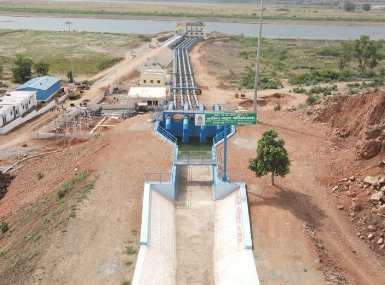
Construction of pump house and canal system
5.2 Time-controlled automated sprinkler irrigation system for greenhouse cultivation
Showcase 5.2: Time-controlled automated sprinkler irrigation system for greenhouse cultivation
Project: Time-controlled automated sprinkler irrigation system for greenhouse cultivation
Location: South Sikkim (Namchi) district, Sikkim
Implementing agency: Agricultural Technology Management Agency, Sikkim
Total financial outlay: ₹5.4 lakh
NABARD assistance: ₹4.8 lakh
Challenge: Improving water-use efficiency in dry area for higher production and yield.
Intervention: Automated time-based irrigation systems optimising soil moisture using sensor and pump set up in greenhouses for horticulture and floriculture.
Beneficiaries: Five flower growers
Output>>Outcomes>>Impact
- 30%–40% water saved.
- Improvement in foliar growth, quality of flowers, plant health, root growth, etc.
- Savings in time and effort due to automated system.
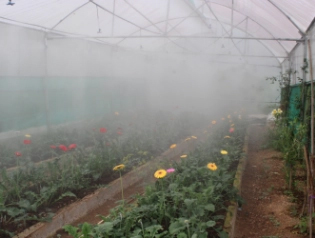
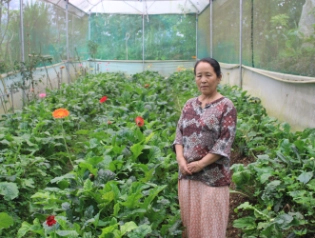
Poly house
5.3 Narmada–Kshipra Link Multipurpose Project
Showcase 5.3: Narmada–Kshipra Link Multipurpose Project
Project: Narmada–Kshipra Link Multipurpose Project, Madhya Pradesh
Location and challenge: Inter-basin water transfer through piped irrigation network to water scarce areas of upper Chambal basin.
Total financial outlay: ₹1,856.7 crore
NIDA term loan: ₹1,745.8 crore
Output>>Outcomes>>Impact
- Irrigation facilities extended to 30,000 hectare in 162 villages across Ujjain and Shajapur districts, enhancing crop yield.
- Quality drinking water supply to over 1.5 million people.
- Diversification to high-value hybrid crops like wheat, maize, gram, and other horticulture crops.
- Rise in farmers’ income up to ₹77,015 per hectare reducing rural–urban migration.

Narmada–Kshipra Link Multipurpose Project, Madhya Pradesh
5.4 Unveiling a mega food park in Himachal Pradesh
Showcase 5.4: Unveiling a mega food park in Himachal Pradesh
Project: Cremica Mega Food Park
Implementing agency: Cremica Food Park Pvt Ltd
Term loan sanctioned: ₹40.2 crore
Location: Haroli, Una district, Himachal Pradesh.
Progress
- The mega food park has an area of 52 acres, of which 23.8 acres is leasable area.
- Entire land is already under possession of the implementing agency and is notified for industrial use.
- The following infrastructure has been completed in the core processing centre:
- Frozen cold store (four stores of 150 MT capacity each)
- Warehouse raw material (3,000 square metre)
- Sewage treatment plant (1.2 million litre per day)
- The construction of a primary processing centre in Solan, Himachal Pradesh is complete.
- Following independent units have set up their manufacturing facility in the food park, which are operational: NEC Retroflex, Trustable Food India Pvt Ltd, Una Miricle Food, and Nijjer Foxtale Con.
Output >> Outcomes >> Impact
- Due to sale/lease of plots, the food park is reporting profits from its own operations.
- The entrepreneurs are optimistic that the Cremica Mega Food Park will be a harbinger of progress for the food processing industry of Himachal Pradesh.
- The Cremica Mega Food Park will potentially maximise value addition, minimise wastage, increase farmer’s income, and create employment opportunities to 8,500 people, particularly in rural sector.
- The mega food park links agricultural produce (potato, tomato, fruits, and meat) to the market by bringing together farmers, processors, and retailers to ensure maximising value addition and food processing.
5.5 Construction of fishing harbour at Tharangambadi in Mayiladuthurai District, Tamil Nadu
Showcase 5.5: Construction of fishing harbour at Tharangambadi in Mayiladuthurai District, Tamil Nadu
Project: Construction of fishing harbour
Location: Tharangambadi in Mayiladuthurai district, Tamil Nadu
Funding
- Project outlay: ₹120 crore
- A term loan of ₹108 crore availed by the Government of Tamil Nadu from NABARD in February 2020.
Challenges addressed
- Fishing is the primary source of livelihood for 10 coastal villages near Tharangambadi in Mayiladuthurai district. The fishing community suffered severe losses during natural disasters, particularly during the 2004 Indian Ocean Tsunami and 2018 Gaja cyclone.
- The fisherfolk had been experiencing difficulties in berthing their boats due to the non-availability of infrastructure.
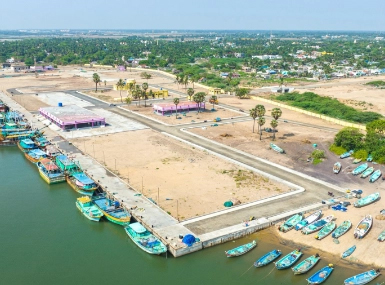
Tharangambadi fishing harbour site
Intervention
- The fishing harbour completed in May 2023 is designed to facilitate the berthing of 800 fibre boats and 225 mechanised boats.
- Other infrastructure facilities include breakwaters structures on both the northern and southern ends of the harbour for boats to enter and exit, slipway, a fish auctioning yard, a fishing net mending shed, an overhead water tank, freshwater sump, vehicle parking area, public toilets, administrative and security buildings, etc.
Output>>Outcomes>>Impact (expected)
- Fisherfolk from Chinnamedu, Vellakoil, Chinnangudi, Kuttiyandiyur, Thazhampettai, Pudupettai, Chandrapadi, Perumalpettai, and Chinnoorpettai can use the new harbour.
- The socioeconomic status of fisherfolk from these villages is expected to improve substantially.
- Additional employment is likely to be generated for
- 3,975 sea-going fisherfolk,
- 2,000 others employed in shore-based establishments, and
- those engaged in distribution and marketing of fish and crustacean products.
- The average annual landing of fish and crustacean of 29,025 tonnes is valued at ₹380.3 crore.
- Fisherfolk can go fishing throughout the year and fully exploit the under-utilised fishery resources.
6.1 Promoting ‘Cooperation among Cooperatives’
Showcase 6.1: Promoting ‘Cooperation among Cooperatives’
Project: Pilot project under the Sahakar se Samriddhi Scheme to promote ‘Cooperation among Cooperatives’
Purpose:
- To promote financial transactions of primary dairy cooperative societies with cooperative banks
- To strengthen cooperative sector and increase its self reliance
- To ensure easy access of rural customers to banking services
Location: Five districts of Gujarat
Implemented by: Banaskantha DCCB and Panchmahal DCCB
Grant support: ₹367 lakh
Challenges faced: Poor access to banking services with distant bank branches
Interventions
- Primary dairy cooperative societies were made business correspondents/bank mitras of DCCBs
- Micro-ATMs were given to the bank mitra dairy cooperative societies with support from NABARD to ensure ease of doing business through digital financial transactions and to promote financial inclusion by offering doorstep financial services to dairy farmers even at remote locations.
- Financial and digital literacy campaigns were organised to create awareness among the members of dairy cooperative societies on the capabilities of micro-ATMs and the services offered under the campaign.
- Opening of bank accounts of dairy societies and their members with DCCBs was promoted.
- KCCs were promoted and distributed by DCCBs to members of dairy cooperative societies.
Output>>Outcomes>>Impact
- Geographical coverage
- Micro-ATMs deployed in PACS: 465 (440 with NABARD support)
- Micro-ATMs deployed in cooperative milk societies: 1,271 (1,191 with NABARD support)
- Financial inclusion and new accounts
- New savings accounts opened: 3.9 lakh
- Financial transactions increased 50 times compared to 6 months prior
- Agricultural financing facilitation: 77,995 RuPay KCCs issued/reissued.
- Special efforts by the banks: Panchmahal DCCB and Banaskantha DCCB deployed additional micro-ATMs using internal resources, showcasing commitment to long-term financial inclusion initiatives.
- Benefits for DCCBs:
- Micro-ATMs at dairy societies helped banks improve their customer engagement by providing financial services to those living far away from bank branches, saving travel costs and time.
- The DCCBs witnessed increase in deposits as well as expansion of the loan portfolio.
- Many cooperative milk societies shifted their accounts from other banks to these DCCBs
- Benefits for cooperative societies:
- Dairy farmer members of primary dairy cooperative societies were able to get affordable and timely credit through Rupay KCC from DCCBs.
- Digital transactions through micro-ATMs improved transparency in operations of dairy societies.
- Their miscellaneous income improved through commission/fee income as bank mitras.
- In view of the success of the pilot project, the campaign on ‘Cooperation amongst Cooperatives’ was launched in all districts of Gujarat by the Chief Minister of Gujarat on 15 January 2024.
Conclusion: The project is a beacon of the transformative potential of digital banking. By fostering financial inclusion and cooperation among cooperatives, it has breathed new life into rural economy, paving way for sustainable growth and prosperity.
ATM = Automated Teller Machine, DCCB = District Central Cooperative Bank, KCC = Kisan Credit Card, PACS = Primary Agricultural Credit Societies.
6.2 Paradigm shift through financial literacy, Bihar
Showcase 6.2: Paradigm shift through financial literacy, Bihar
Project: Running a Special Financial Literacy Programme and enabling access to banking services for rural communities
Location: Bihar
Implemented by: Dakshin Bihar Gramin Bank
Grant assistance: ₹140.1 lakh
Challenges faced: The communities faced lack of awareness about banking services and had limited access to livelihood opportunities.
Intervention: Implementation of extensive awareness generation programmes
Output>> Outcomes>>Impact
- Geographical coverage: 46,366 participating beneficiaries from 1,046 villages across 20 districts
- Accounts opened:
- PMJDY new accounts opened: 13,039
- PMJJBY enrolments: 17,267
- Savings bank accounts opened: 11,480
- Credit cards issued/reactivated: 977
- PMSBY enrolments: 23,255
- APY enrolments: 7,700
- Debit cards issued: 1,403
- Credit cards issued/reactivated: 977
Spotlight on Aropur
Aropur village is located in Bihar’s agricultural heartland. Previously lacking in financial literacy, now nearly half the villagers have opted for banking services, resulting in over 1,920 new accounts being opened. As a result:
- The utilisation of crucial government initiatives (PMSBY, PMJJBY, and APY) has improved significantly.
- Over 150 small farmers are receiving support from programmes such as KCC and PM-KISAN.
- The establishment of 50 self-help groups has fostered financial independence of women and their sense of empowerment and community cohesion.
- Entrepreneurs have leveraged PM Mudra Yojana loans to grow their businesses, generating incomes and employment locally through the establishment of new production units.
- Additionally, under PMAY–G, four villagers are now proud owners of permanent homes.
Conclusion: Through collaborative efforts and targeted interventions, Dakshin Bihar Gramin Bank, with NABARD’s support, has significantly improved financial literacy, access to banking services, and digital awareness among rural communities, paving the way for inclusive growth and development in rural Bihar.
APY = Atal Pension Yojana, KCC = Kisan Credit Card, PMAY–G = Pradhan Mantri Awaas Yojana–Gramin, PM-KISAN = Pradhan Mantri Kisan Samman Nidhi, PMJDY = Pradhan Mantri Jan Dhan Yojana, PMJJBY = Pradhan Mantri Jeevan Jyoti Bima Yojana, PMSBY = Pradhan Mantri Suraksha Bima Yojana.
A10.1 From vision to venture: NABFINS-backed entrepreneurs propel growth
Showcase A10.1: From vision to venture: NABFINS-backed entrepreneurs propel growth
Sulochna Sao, from Chhattisgarh, has embarked on a remarkable entrepreneurial journey in the snack manufacturing sector. With NABFINS support channelled through the joint liability group (JLG) she was a member of, Sulochana steered her enterprise to noteworthy success. Through her unwavering commitment and industriousness, she has not only expanded her enterprise but also fostered local employment opportunities and stimulated economic growth.
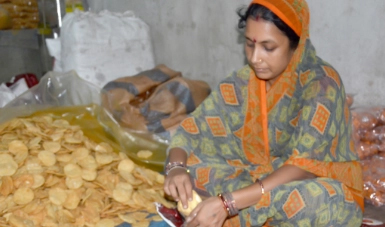
Sulochana Sao, a member of JLG from Raigarh, Chhattisgarh
A10.2 Micro loans, macro change
Showcase A10.2: Micro loans, macro change
Karmina Bibi, like many others in her community, previously lacked access to proper water, sanitation, and hygiene (WASH) facilities, leading to health risks and discomfort. When NABSAMRUDDHI gave a concessional loan to Grameen Shakti Microfinance, the first unrated entity in its WASH portfolio, the latter provided a loan to Karmina for building a new toilet. The toilet not only improved her family’s hygiene practices but also enhanced their overall well-being and dignity.

Karmina Bibi, next to her newly constructed toilet
© 2024 NABARD All Rights Reserved
Designed & Developed by RDX Digital
